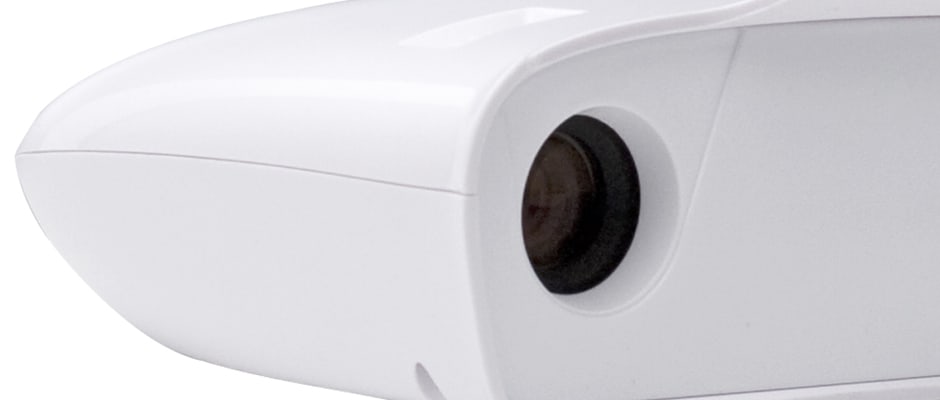Introduction
Front
- Looks attractive.
- Feels a bit cheap.
- Plasticky construction.
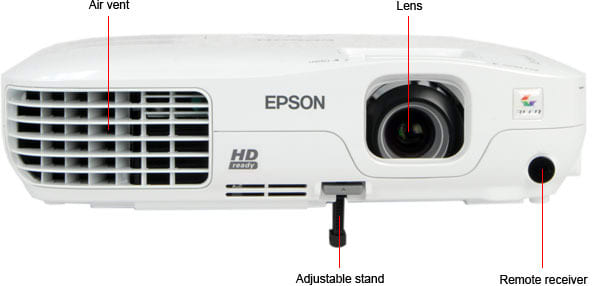
Back
{{section_header}}{{section.name}}{{/section_header}}
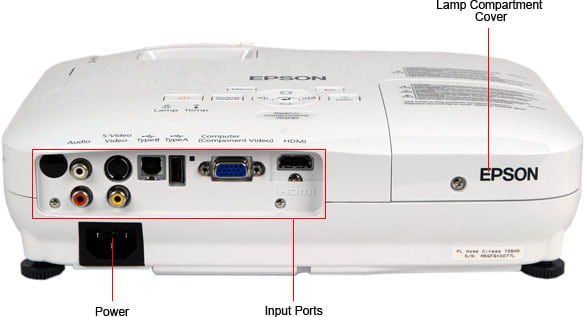
Sides
{{section_header}}{{section.name}}{{/section_header}}
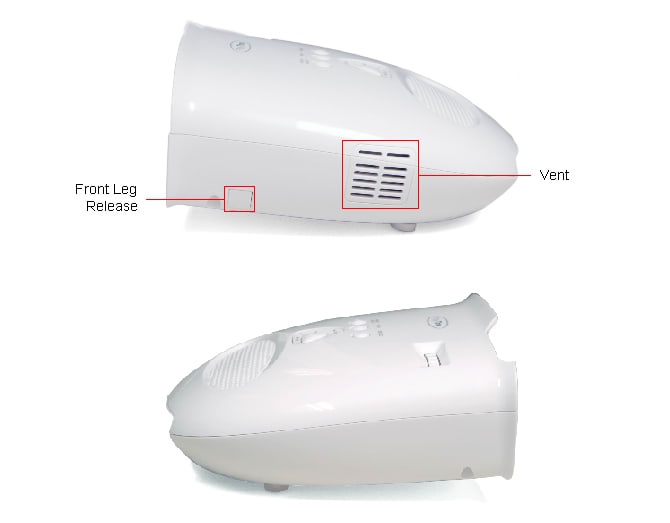
Top/Bottom
{{section_header}}{{section.name}}{{/section_header}}
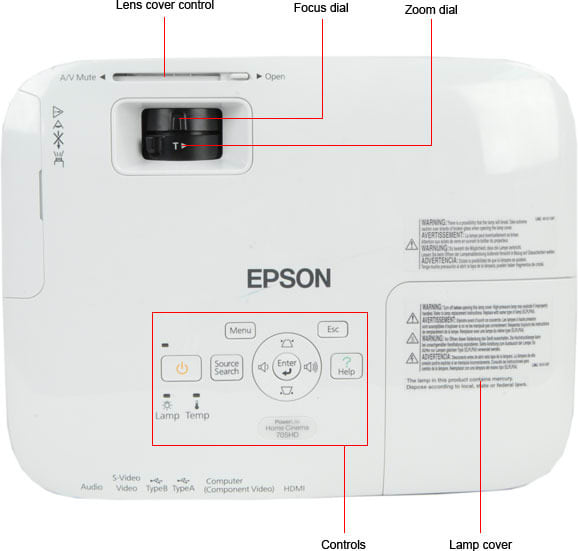
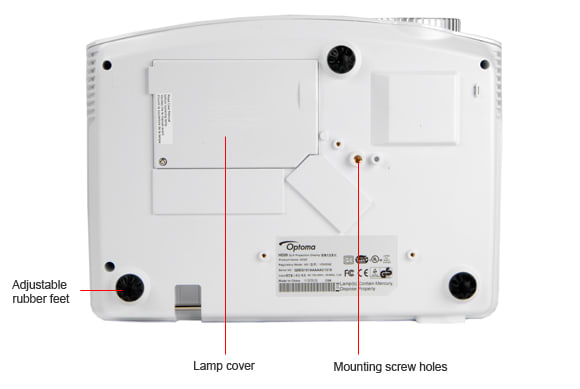
Stand/Mount
{{section_header}}{{section.name}}{{/section_header}}
The Optoma PT100 has two movable legs. The front leg is locked in position and can only extend if the button on the projector's left side is pressed. The back leg can be turned like a screw to extend or retract.
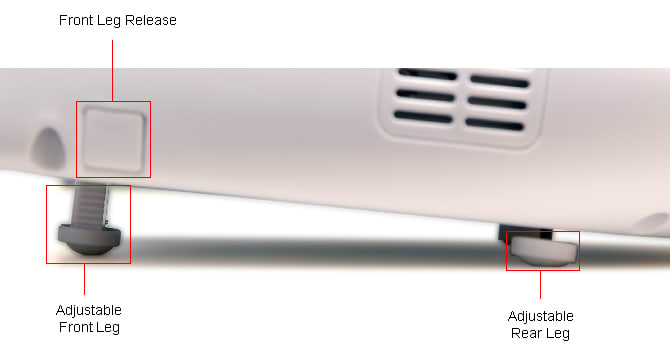
Lamp
Remote Control Tour
{{section_header}}{{section.name}}{{/section_header}}
The projector doesn't come with a remote control.
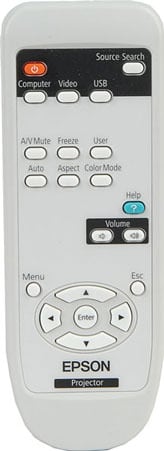
The small remote control of the 705HD
In the Box
{{section_header}}{{section.name}}{{/section_header}}
In the box you'll find the projector, manuals, and an analog A/V cable.
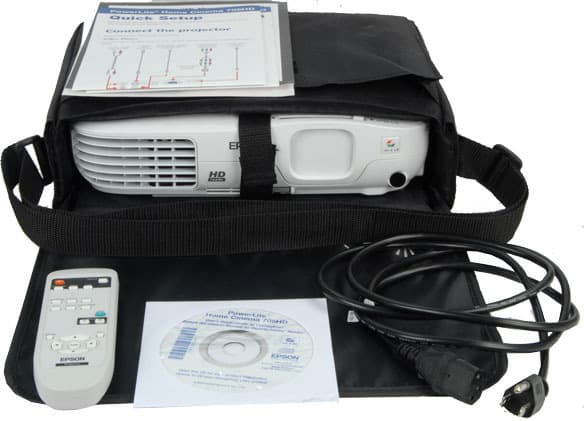
The 705HD comes with a carrying case, manuals, power cable and remote
Portability
{{section_header}}{{section.name}}{{/section_header}}
The projector doesn't weigh a lot and isn't very big. It doesn't come with a backpack like the GT720 (Optoma GameTime GT720 Review), but it's still fairly portable.
{{product.raw_scores['Portability']}}
Setup Assistance
{{section_header}}{{section.name}}{{/section_header}}
There isn't much to do to set up this projector. Just put it on the table, fiddle with the legs until you have a reasonably straight image, and plug in all applicable cables. There isn't any assembly required.
{{product.raw_scores['Setup']}}
Aesthetics
{{section_header}}{{section.name}}{{/section_header}}
The PT100 isn't the most gorgeous projector we've seen, but it does have a fairly nice facade. While it does look a bit plasticky if you examine it too closely, and its light weight certainly portrays a kind of cheapness, the unit itself doesn't look too bad.
Peak Brightness
{{section_header}}{{section.name}}{{/section_header}}
- Very low peak brightness.
- Has trouble maintaining its black level.
Peak brightness is very important for a projector. Without a high peak brightness the onscreen image can easily get washed out by ambient light. A low peak brightness also really limits the maximum contrast ratio you can squeeze out of the projector.
Peak Brightness
The Optoma PT100 has a really, really low peak brightness. Unless you're sitting in a totally dark room, the picture is going to look very, very washed out.
{{image_chart title="Peak Brightness", attachment="Peak Brightness Comparison Graph"}}
Tunnel Contrast
{{section_header}}{{section.name}}{{/section_header}}
The PT100 had some minor issues with tunnel contrast. When 90% of the screen is black, the projector maintains a black level of about 0.03 cd/m2^ (candelas per square meter). As the percentage of black on the screen shrinks, the black level gradually creeps up, peaking at 0.2 cd/m2. Fortunately, this isn't really a bad black level and since the black level increases gradually, it won't likely be perceptible for the average user.
Tunnel Contrast
Uniformity
{{section_header}}{{section.name}}{{/section_header}}
The Optoma PT100 didn't really have any issues with screen uniformity: the screen was just uniformly dim. Typically brighter projectors have trouble maintaining luminance towards the outside of the screen, but due to the PT100's low luminance output, it doesn't have trouble maintaining an unblemished display.
Greyscale Gamma
{{section_header}}{{section.name}}{{/section_header}}
The projector had a pretty accurate greyscale gamma all things considered. Greyscale gamma ensures each shade from black to white is equally emphasized in a nice even progression. Although the PT100 can't muster a very bright white, it keeps its greys incrementing at even intervals.
Greyscale Gamma
Color Temperature
The PT100 had some pretty serious problems with color accuracy. Not only did it have inaccurate RGB curves, but its color gamut was off and it wandered warm throughout most of the greyscale spectrum.
{{section_header}}{{section.name}}{{/section_header}}
The projector's color temperature had inconsistent spikes. It would get warm suddenly for a short band of greyscale, then retreat to an imperceptible bias. What does this mean for the average viewer? Some shades will appear more reddish than they should.
Color Temperature
RGB Curves
{{section_header}}{{section.name}}{{/section_header}}
The curves in the graph below are supposed to be smooth. Smooth curves indicate a nice, even progression from dark to saturated. Inconsistencies represent at seem to have any issues with its RGB curves.
RGB Curves
Color Gamut
{{section_header}}{{section.name}}{{/section_header}}
The projector's color gamut is also pretty far off. The blue and green points are both very undersaturated and shifted clockwise along the color gamut. That means blues and greens might look slightly skewed. The projector's red point is closest to accurate, but it's still a little off. The point that users are most likely to notice, however, is the TV's white point, which is very, very far into the blues.
Color Gamut
Below we've listed our measurements for the projector's red, green, and blue points.
Motion Smoothness
{{section_header}}{{section.name}}{{/section_header}}
The Optoma PT100 had decent motion performance. Images with fine, complex detail will show break-up more than areas of flat or little detail, as you might expect. Overall, we noticed a slight stutter in moving images, but it wasn’t too bad. Strictly speaking about motion smoothness, there was no difference from one resolution to another.
Motion Artifacting
{{section_header}}{{section.name}}{{/section_header}}
The main artifacting issue the PT100 has is images lost a significant amount of detail when they start moving around. Fine gradations in color are lost, which makes images look flat.
3:2 Pulldown & 24fps
{{section_header}}{{section.name}}{{/section_header}}
The Optoma PT100 has no specific modes or processing features to aid in the rendering of native 24fps content, but it can display it effectively enough (some projectors can’t handle 24fps at all). In testing, we noticed that the PT100 showed some problems with high frequency patterns, and some slight stuttering when the camera pans horizontally. Overall, though, it was rather good.
Resolution Scaling
{{section_header}}{{section.name}}{{/section_header}}
The PT100 has a native resolution of 854 × 480 (WVGA), and has a hard time handling other resolutions. We couldn't get the projector to work at all with a 1080i feed.
720p
With 720p content, the Optoma GT720 showed major problems with high frequency patterns. There was an incredible amount of Moire. Also, fine text was difficult to read.
1080p
When we fed the Optoma PT100 a 1080p signal, it looked glitchy and bad. Text was virtually unreadable and colors were very, very off.
Throw
{{section_header}}{{section.name}}{{/section_header}}
The Optoma PT100 has a long throw and no zoom lens. This means you should make sure the room is big enough before you buy this product. making it a not-terribly-flexible projector. You need to position it just so in order to fit it correctly to your screen. An 80-inch screen requires a distance of 13 feet, 3 inches.
Ignore the second row of values in the chart below. Because there’s no zoom lens, the wide angle and telephoto are the same.
Screen Brightness
{{section_header}}{{section.name}}{{/section_header}}
The screen brightness produced by the Optoma PT100 falls off rather quickly as you move the projector further back from the screen. It’s the same for any projector, but the PT100 is super dim as it is. The chart below should give you some idea of whether the Optoma GT720 is right for your particular room layout.
Screen Materials
{{section_header}}{{section.name}}{{/section_header}}
You won’t always have a dedicated projector screen or perfectly white wall to project onto. For just such a reason, we check projectors’ images against a grey painted wall, a beige painted wall, wood paneling, and a dry-erase board. We saw the expected color shifts, and unfortunately there’s no easy way to correct the colors. The menu offers an option for correcting colors to a black board surface, but no other type of surface.
Optical Issues
{{section_header}}{{section.name}}{{/section_header}}
There were virtually no optical issues with the Optoma PT100. In this test, we look for ghosting, color aberrations, or barrel distortion from the lens. We saw none of these problems.
Video Processing
{{section_header}}{{section.name}}{{/section_header}}
The projector doesn't have any video processing features.
Formats
{{section_header}}{{section.name}}{{/section_header}}
The Optoma PT100 is a native WVGA projector (854 x 480), and has some severe difficulties displaying non-native content. We could get it to display 480p, 720p, and occasionally 1080p content, but there were significant issues the latter two.
Calibration
{{section_header}}{{section.name}}{{/section_header}}
There isn't much you can do to calibrate the PT100. All it has are three video modes. We found the Bright mode was the most accurate one.
Video Modes
{{section_header}}{{section.name}}{{/section_header}}
The projector has three video modes: Bright, Standard, and Video.
Input Ports
{{section_header}}{{section.name}}{{/section_header}}
The projector has one set of analog audio inputs, a composite video input, and a VGA input.
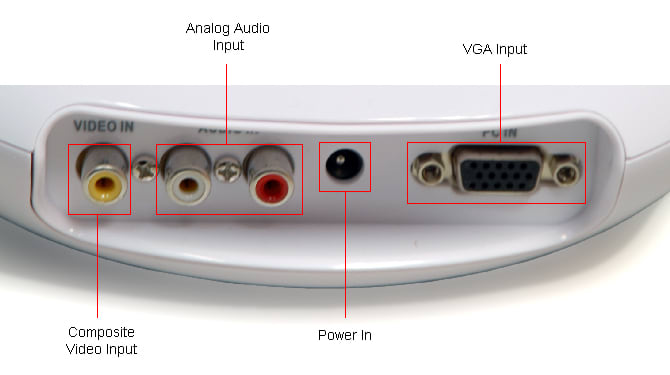
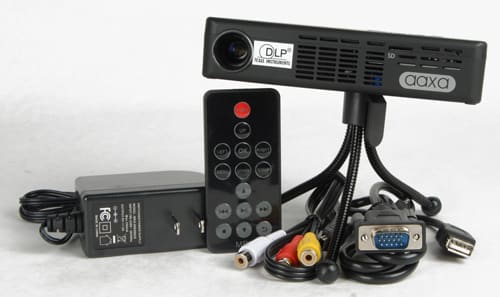
Lots of cables are included
All the ports are listed below, compared with the competition.
Other Connections
{{section_header}}{{section.name}}{{/section_header}}
The projector has no other connections.

Placement
{{section_header}}{{section.name}}{{/section_header}}
The ports are placed at the very back of the projector. They're fairly easy to access.
Internet & Media Features
Menus & Manual
{{section_header}}{{section.name}}{{/section_header}}
The projector's menu is easy enough to use, since it's ridiculously simple. Unfortunately, the instruction manual is pretty bad. It doesn't seem like there'd be much to cover in the manual, given how simple the projector is, but the manual doesn't really offer any information of use.
Noise
{{section_header}}{{section.name}}{{/section_header}}
The Optoma PT100 is not particularly noisy. With an ambient room level of 34.8dB, the noise increased to 39.2dB with the projector on and in Bright Lamp mode. If you put the lamp in Standard Mode, the noise decreases only slightly.
{{image_chart title="Noise", attachment="Noise Graph"}}
Heat
{{section_header}}{{section.name}}{{/section_header}}
The projector doesn't run very hot either. We found it only warmed the air by about 10°. Considering some projectors can heat up a room five times as much, the PT100 shouldn't cause many issues.
{{image_chart title="Heat", attachment="Heat Graph"}}
Power Consumption
{{section_header}}{{section.name}}{{/section_header}}
The projector also doesn't consume much in the way of electricity. Assuming average use, it'll run about $20 per year.
Lamp Life
{{section_header}}{{section.name}}{{/section_header}}
Optoma estimates that the lamp will run 5000 hours.
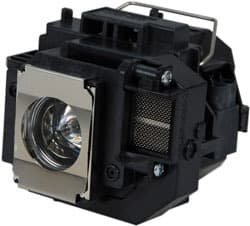
The lamp of the 705HD
Value
{{section_header}}{{section.name}}{{/section_header}}
In this match-up, the Optoma is definitely the better value, assuming you don't care much about picture quality. If you demand quality and a high level of performance from your projector, however, the Canon is the clear choice. The Optoma isn't a professional-grade projector.
Blacks & Whites
{{section_header}}{{section.name}}{{/section_header}}
The Canon is significantly brighter than the Optoma and has fewer problems with tunnel contrast.
{{image_chart title="Contrast", attachment="Contrast Graph"}}
Color
{{section_header}}{{section.name}}{{/section_header}}
Again, the $729.95 projector manages to solidly out-perform the $179.99 projector.
Motion
{{section_header}}{{section.name}}{{/section_header}}
The PT100 loses a great deal of detail when objects are in motion. The Canon handles motion like a champ.
Viewing Effects
{{section_header}}{{section.name}}{{/section_header}}
The Optoma has a set throw distance: there's no zoom to it, so you're pretty much stuck 13 feet away from the screen. The Canon LV-8310 has a 1.2x zoom, which gives it significantly more flexibility.
Connectivity
{{section_header}}{{section.name}}{{/section_header}}
The Optoma has two options for video input. Two. And only one for audio input. The Canon is prepared for just about anything.
Value
{{section_header}}{{section.name}}{{/section_header}}
The Optoma HD66 is definitely the better projector in terms of performance and overall capability, but with a $600 price tag, it's certainly not for everyone. If you want to try out a projector, but don't want the purchase to leave you destitute, the Optoma PT100 is definitely a better entry-level option.
Blacks & Whites
{{section_header}}{{section.name}}{{/section_header}}
The HD66 is significantly brighter and does a better job maintaining its black level. The PT100 is very, very dim and we wouldn't recommend using it in anything but a completely darkened room.
{{image_chart title="Contrast", attachment="Contrast Graph"}}
Color
{{section_header}}{{section.name}}{{/section_header}}
The HD66 has much more accurate color performance overall.
Motion
{{section_header}}{{section.name}}{{/section_header}}
The PT100 had some issues with its motion performance: moving objects lost a great deal of detail. The HD66 didn't have the best performance in this area, but it certainly outclassed the PT100.
Viewing Effects
{{section_header}}{{section.name}}{{/section_header}}
Connectivity
{{section_header}}{{section.name}}{{/section_header}}
Value
{{section_header}}{{section.name}}{{/section_header}}
The Optoma is an entry-level projector that doesn't offer much in the way of features or picture quality. It's a projector for $180, making it affordable for people who want to see if projectors are right for them but don't want to invest much into the experiment. The Epson PowerLite 705 HD costs significantly more and it shows: the projector's picture quality utterly blows the PT100's out of the water.
Blacks & Whites
{{section_header}}{{section.name}}{{/section_header}}
The PT100 barely outputs any light at all, and will look washed out even in a moderately-lit room. The Epson PowerLite 705 HD outputs significantly more light and can maintain its black level much easier.
{{image_chart title="Contrast", attachment="Contrast Graph"}}
Color
{{section_header}}{{section.name}}{{/section_header}}
The PT100 has some pretty inaccurate color representation. The Epson PowerLite 705 HD offers much better performance in this area.
Motion
{{section_header}}{{section.name}}{{/section_header}}
We saw a significant decrease in the detail of moving objects with the PT100. The Epson PowerLite 705 HD handles moving images much better.
Viewing Effects
{{section_header}}{{section.name}}{{/section_header}}
The PT100 doesn't feature a zoom, so you need to be very flexible in where you can place the device. The Epson PowerLite 705 HD features a zoom lens, which gives users a bit more leeway with its placement.
Connectivity
{{section_header}}{{section.name}}{{/section_header}}
The Epson PowerLite 705 HD is prepared for pretty much anything you want to hook it up to. The PT100 only has a composite video in and a VGA port for video, and one set of analog audio inputs between them.
Conclusion
The Optoma PT100 isn't one of the better projectors we've reviewed, performance-wise. It's lamp outputs barely any light, and even in a dimly-lit room you'll find its image looks washed out. The PT100 didn't put up great numbers on any of our picture quality tests, but we also don't fault it for its performance. Most of the projectors we've reviewed so far are more than three times as expensive as the PT100. The PT100 isn't for business reps making a presentation or cinephiles who need the best picture quality. It's meant to be a cheap, portable projector, and it succeeds on those counts. If you're just looking for an inexpensive way to get a big image, the PT100 will meet your needs.
Meet the tester
Mark Brezinski works on the Home Team, reviewing refrigerators, minifridges, dishwashers, washing machines, dryers, air conditioners, air purifiers, and fans.
Checking our work.
Our team is here to help you buy the best stuff and love what you own. Our writers, editors, and experts obsess over the products we cover to make sure you're confident and satisfied. Have a different opinion about something we recommend? Email us and we'll compare notes.
Shoot us an email